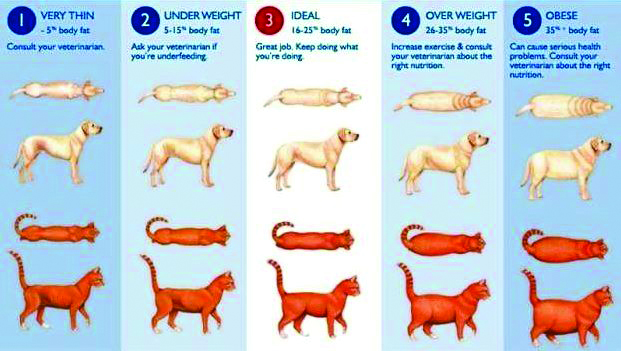Huntsville Pets Helping People: Loving Our Pets To Death
Have you looked at your pet lately? Of course you have. But have you really looked at them? What is their body condition? Have the pounds crept up on your beloved dog or cat? Just like people, many of our pets are becoming overweight or obese. In fact, over the past decade, pet obesity has become so prevalent that it is now an epidemic. It is estimated that 50 million dogs and 56 million cats or about 50 percent of our pets are overweight or obese. If an animals is less than ten percent over their ideal weight, they are overweight. Once they are ten to twenty percent over their ideal weight, they are obese. So when a small dog who should weight about ten pounds tips the scale at twelve and a half pounds, they are obese.
Just like people, pets become overweight as the result of taking in too many calories and not getting enough exercise. Of course, there are some individual animals who have gained weight because of a medical condition or medications they are taking, but they are a tiny minority of the obese pet population. Most obese pets move too little and eat too much.
Just like people, pets with excess pounds may develop serious health issues which could shorten their life spans. Obesity may lead to heart disease, diabetes, high blood pressure, arthritis, and spine or joint issues that impact the pet’s mobility. However, there are other medical concerns. Obese pets are harder to diagnose when they are sick. The layers of fat over their organs make it harder for veterinarians to hear heart beats and breathe sounds or to palpitate the abdomen and other body structures. Just like people, obese pets present anesthesia challenges. They have lower lung capacity because fat layers restrict full expansion of the lungs. In addition, obese pets may be under anesthesia for a longer period of time as the veterinarian works thru and around layers of fat that interfere with surgeries. Another issue is obese pets may experience liver and kidney function issues that could be adversely effected by anesthesia. There are a couple other concerns for overweight animals – temperature and grooming. In hot weather, obese pets have a harder time cooling off. In addition, pets with extra pounds may have difficulty with self-grooming.
How do you know if your dog or cat is overweight? A quick check is to feel their ribs. Just looking is not sufficient, especially if your pet has abundant fur. Touch your pet’s ribs. If you can easily feel individual ribs, the animal may be in an acceptable weight range. If the ribs seem to be padded, they may be overweight. In any case, talk with your veterinarian about your pet’s weight. In most vet offices, you will see a body condition chart on the wall. The chart will show dog and cat body conditions from very thin to obese. The chart is intended to educate the public about body conditions. However, based on surveys, it turns out that most people cannot correctly estimate their pet’s body condition. They are overly optimistic and see their pet as having a good weight even if the animal is determined to be overweight by a veterinarian. Your veterinarian can discuss the diet, nutrition, and exercise needs of your specific pet. Please keep in mind that the talk is not about judging the pet owner. It is all about the animal’s health.
That said, here are a few thoughts on pet nutrition and exercise. Pets need good quality food to maintain good health and weight. The cheapest grocery store brand of food will not do the job. Buy the best food that you can that will not break your budget. Measure the amount of food that is given to your pet to avoid overfeeding them. Ask your veterinarian the amount of food to feed your pet. Going by the number of cups to feed your pet on the dry food bag will almost certainly cause you to overfeed. Please do not give them table scraps and eliminate free feeding (leaving food out all the time). To lose weight, pets need less calories but the age of the pet and their breed size come into play too. That is why it is important to obtain veterinary input for a weight loss plan for your pet.
Most dogs are up for some form of exercise. Walks are usually a first thought but play can be good too. One or more walks a day is recommended. As the dog becomes accustomed to walks, the duration and distance of each walk can be increased. Playing with toys may be helpful too but not all dogs play with toys and many dogs only want to chew on them and not run around the yard with the toys. Cats need exercise too. Some cats are willing to go for a walk using a harness and leash but most will not. However, many cats will chase a laser light or pursue a feather attached to a dowel by a string. Aim for getting a cat to play for ten minutes at a time twice a day.
Our pets depend upon us to provide them love, shelter, and nutritious food. Since pets cannot prepare their own meals, we control what our pets eat and when they have access to it. It is up to us to feed them in a manner that contributes to their overall wellbeing. Overfeeding them is not a sign of love. Instead, it is a harmful act. We want our pets to live long and healthy lives. Feeding them quality food in the proper amount and maintaining a proper weight for their age and size will help them live longer happier and healthier lives. That is what good pet parents do.
















